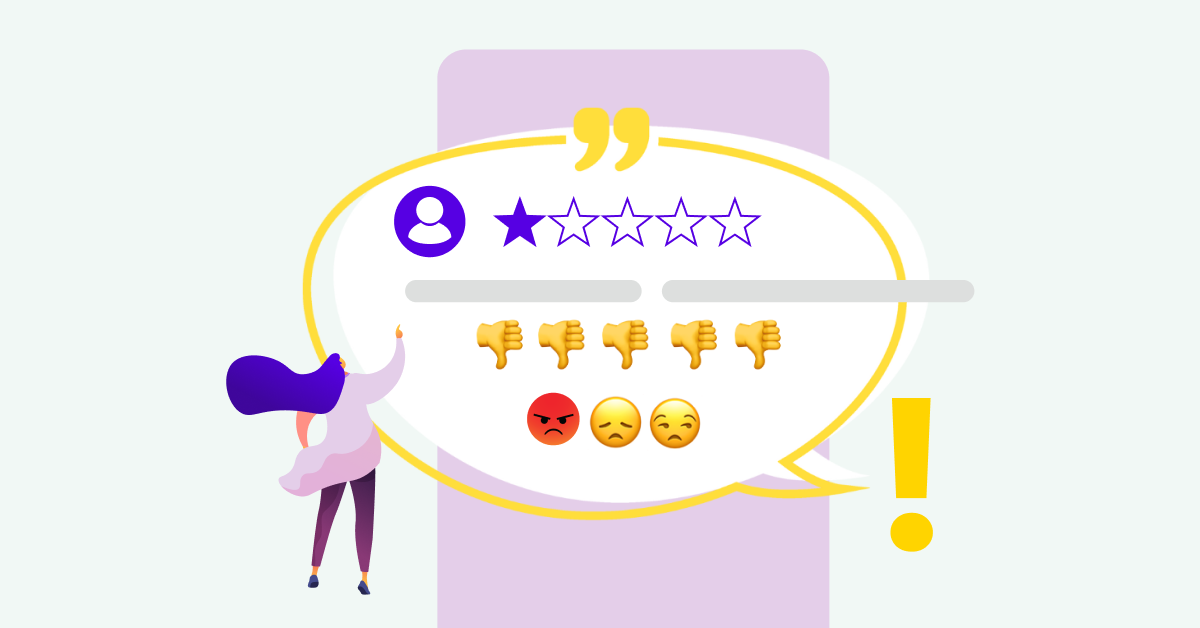Sour expression. Frowning face. Crossed arms. Short responses.
These are the classic signs that understand how to deal with unhappy customers.
In the eCommerce world, this translates to a review that looks like this:

Or it can also come in the form of a strongly worded phone call.
Irate customers can also send you a couple of emails just telling you how unpleasant their experience was with your brand.
No matter what form you receive it, angry or difficult customers are not easy things to manage.
Maybe your product or service did not meet their expectations. Or perhaps it was an honest mistake on both ends.
Even so, you can see their business slipping away from you.
But it's not the end of the world!
As an eCommerce business, managing unhappy customers is part of the job.
When you do it right, you can build rapport and improve your relationships with all your customers.
That's right; you can turn unhappy customers into brand advocates!
All it takes is giving them great customer service through your attitude and care.
So how do you deal with an irate customer?
Let's start by knowing...
What Are The Types Of Difficult Customers You'll Meet?
There are different kinds of customer complaints you're about to handle. Learning which ones you are meeting will help you resolve their complaints more efficiently.
The first ones are...
Impatient Customers
This type of unhappy customer may be in a hurry as they might have other things to do.
They might encounter a problem while purchasing from your business. Or they need more information before buying.
Your customer will try to contact you then. If they find out that your customer service is through email, they will feel impatient for not having an immediate response.
The next type you might encounter is...
Angry Customers
You try to resolve the issue at hand. But an angry customer will not be satisfied with any attempts you make.
They may have more grievances than one another. They can also verbally abuse you when you try to respond to their concerns.
A poor experience can also get you...
Demanding Customers
These dissatisfied customers are dead set on what they want from your business.
Sometimes they would request discounts or refunds without providing much evidence. Even when you offer alternatives, they think that what they demand is still better.
And lastly, you might also meet...
Unhappy Customers
Even if you do your best to resolve your customer's problems, they will still feel dissatisfied with it.
They can turn into a rude customer out of frustration.
Sometimes, they can dismiss your resolutions and cut you off during conversations.
Sounds like a nightmare, right?
Don't worry... You can turn these situations into a pleasant dream that can gain their brand loyalty!
Keep your positive reputation with the...
8 Efficient Tips For Managing Difficult Customers

1. Listen
Sounds easy, eh?
Well, buckle up. Because it takes more than your ability to hear to make your customer feel heard.
Dealing with upset customers means you have to practice active listening.
What does this mean?
It entails paying close attention to everything your customer is saying. Actively listening also means looking for the root cause of your customer's concerns, instead of their anger.
This way, most of your conversation will be about resolving the issue, instead of convincing your customer to remain calm.
Here are ways you can actively listen to your customers in a conversation:
- Whether through the phone or email, do not talk over your customers. Let them express their feedback during your conversation.
- Ask neutral questions to gain more information.
- As you listen, make sure that you are recording all of the details for a clearer understanding.
- If their concerns are done through email or reviews, read it twice before you respond.
As you respond to an upset or angry customer, the most important thing you have to do is to...
2. Stay Calm
Remaining calm when you are under fire can be a hard thing to do.
But remember... Conflict is part of running a business. And so does aiming for an excellent customer experience.
So don't lose your temper! It's tempting to match an angry customer's voice and respond just as angrily.
However, your customers don't want to get screamed at. They just want to be heard.
And getting irate yourself won't solve the issue at hand.
To keep calm when dealing with an angry customer, you can...
- Go over your response twice or thrice. Make sure that you don't use any aggressive phrases.
- Step away for a couple of minutes. Having a fresh eye on your response can help you filter out any angry words.
- Maintain a low tone while still being assertive.
Staying calm as you listen will also calm angry customers. Their anger will slowly dissipate when they see how steadfast you are.
When you speak to a difficult customer, don't forget to...
3. Thank Them For Their Feedback
Thanking an angry customer might sound contrary.
But trust me...
Showing your appreciation for bringing their complaints to your attention goes a long way when building trust.
Let me explain.
A simple thank-you is a way for you to acknowledge their opinions expressed.
It's also about recognizing their time and patience as you look for a solution. This can promote your business in a positive light and improve your customer relationship.
Here are some tips when you express your gratitude:
- Constantly say thank you. For example, say it when a customer has any inquiries.
- When putting them on hold, thank them for patiently waiting as you work on a solution.
- Thank them when they leave reviews on your product or service, either positive or negative.
An unhappy customer also expects the next one from you...
4. Apologize For The Inconvenience And Empathize

Remember... on the other side of the customer conversation is a real person.
And when you apologize, it can validate your customer's feelings.
It also shows that you care about each customer that buys from you. Empathizing with your customer can mend their trust in your business.
To show empathy through your apology, you have to...
- Be thorough when you say sorry.
- Give a brief explanation. Don't give out any excuses, and move forward.
For example, saying, "I'm sorry for the inconvenience is okay."
But you do better by saying... "I'm sorry our service did not match your expectations. This is not the quality we are aiming for. Here is what happened..."
And to make it more sincere, you need to...
5. Use Your Customer's Name
Dale Carnegie sums it up best:
"A person's name is to that person the sweetest and most important sound in any language."
That's right... Using your customers' names when you speak to them is a powerful thing.
Addressing a customer through their name is a good strategy for personalization.
It shows that your focus is entirely on them, and you respect them. It can also be a good reminder that they are talking to a human instead of an automated bot.
Most customers would feel comfortable when you:
- Use their name moderately. It can get awkward when you address them too much.
- Also introduce yourself at the start of the conversation.
Now that you have your customer's attention, it's time to...
6. Explain The Steps For A Solution
Resolving your angry customer's issues is your goal, after all.
Here is how you can make the process easier:
- Break the problem into manageable "bite-sized" pieces. Take one small portion at a time. Doing so will help you deal with it efficiently.
- You can walk your customer through the process if you find an easy fix.
- Use simple and clear terms when you explain the solution to them.
- If the solution will take some time, be honest. Keep your customer updated. Set their expectations so they have a timeline of when their issue can be resolved.
And keep this in mind...
Make your expectations realistic! That way, you can meet said expectations to your customer's satisfaction.
To make sure your customer walks away satisfied...
7. Make Yourself Easily Reachable
I'm sure you have experienced being put on hold before.
And when you're put on hold for a long time, the elevator music can break a person's patience.
You can prevent escalating the situation by having an open line of communication. Having an easy way to ask for your help can help build trust even with the most upset customer.
To create an open line with a customer, you can:
- Clearly display your contact information on your eCommerce site.
- Offer a multi-channel submission for your customers. That includes mobile phone, email, web, etc.
- Install Debutify's Add-On, Facebook Messenger. It adds the Facebook Messenger chat widget to your store.

- Quickly respond. The faster you reply to an upset customer, the better. Letting them stew on their grievances will let their anger build more.
Lastly, make sure that you...
8. Follow Up
If you promise to call a customer back... call back!
Even if the update is not to their liking, it's important that you follow up.
It will reassure them that you are working on a resolution and are not dodging them.
Ensure that both you and your customer agree on the time you are set for a follow-up.
That's how you painlessly deal with angry customers! Now it's up to you to...
Keep Your Customers Happy!
Sometimes, dealing with unhappy customers can be stressful.
You may even ask yourself, "Is it worth my time?"
Think of it like this: Don't take your customer's anger personally. Take it as an important learning moment.
Managing unhappy customers will give you insightful lessons. It can help you focus on the part of your products or services that needs some work.
And the better your customer experience gets, the more success you'll achieve. So, what should you do?
Use an app that will help you turn negative reviews into a positive experience! Yep, that's Debutify Reviews!



